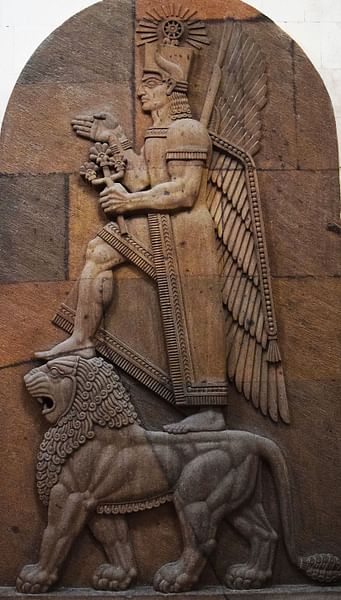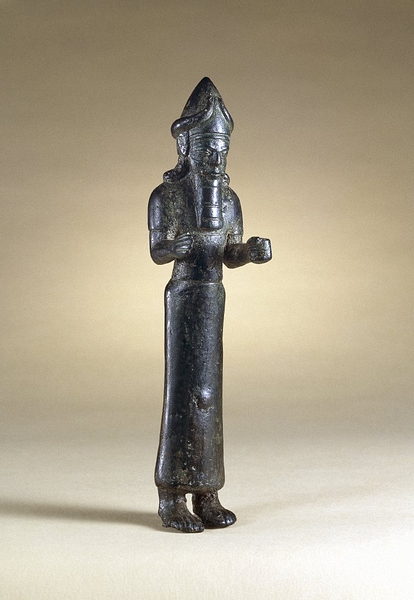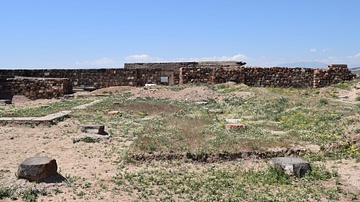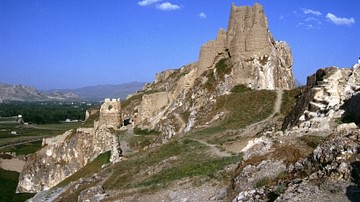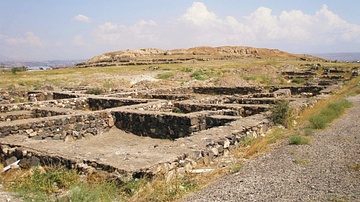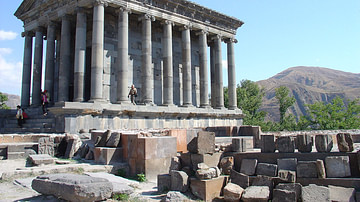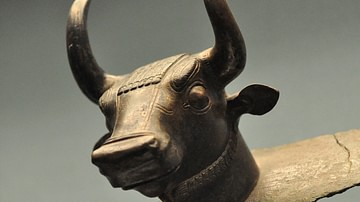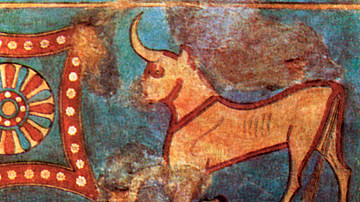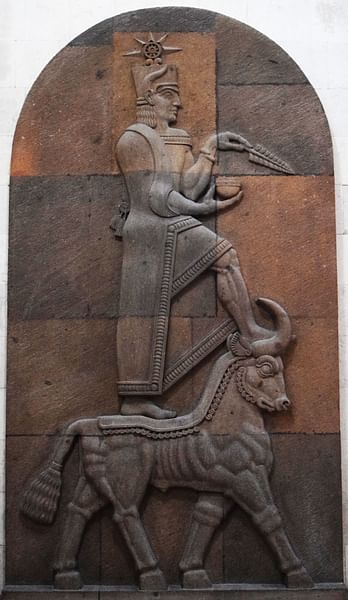
The religion of the Urartu civilization, which flourished principally in ancient Armenia from the 9th to 6th century BCE, was a unique mix of indigenous, Hurrian and Mesopotamian gods and symbolism. The pantheon was headed by the trinity of Haldi, Teisheba, and Shivini, who were the principal beneficiaries of sacrifices and temples built in their honour. Inscriptions, dedications and representations in art are all a testimony to the importance of religion in Urartu culture and especially to warfare.
The Urartu Pantheon
The gods of the Urartu religion were many, but they are handily listed in a 9th-century BCE inscription discovered in a niche in the mountains near the capital Tushpa (Van). The list, inscribed in duplicate, mentions 79 gods and the various sacrifices which should be made to each. The large number of deities may be explained by the fact that the Urartu religion adopted gods and practices from the Hurrians and other Mesopotamian cultures, which were mixed with indigenous Urartian gods. In addition, a feature of Urartu territorial expansion was the assimilation of local gods into the official pantheon of the conquerors. Many of these local gods were totems and represented such important elements or prominent natural features as water, earth, the sun, mountains, caves and trees. Still other deities were related to ancient animalistic beliefs.
The three most important Urartu gods were Haldi (Khaldi), god of war and the supreme deity, Teisheba, the god of storms and thunder who was likely based on the Hurrian god Teshub, and Shivini, the Sun god, who was often represented as a kneeling man holding a winged solar disk, and therefore likely inspired by the Egyptian god of the same association, Ra. Haldi's consort was Arubani (or Bagmashtu in the eastern part of Urartu, notably at Musasir/Ardini), the most important female goddess; Teisheba's consort was Huba (aka Khuba), and Shivini's was Tushpuea (aka Tushpues). The close cultural relations between Urartu and Assyria are again illustrated by the Urartian application of the Assyrian ideograms for the gods Adad and Shamsh to their own gods Teisheba and Shivani respectively.
Other important gods include Sielardi, the moon goddess, Epaninaue, the land goddess, Dsvininaue, a sea or water goddess, Babaninaue, the goddess of mountains, and Sardi, the star goddess. Most towns were given their own local god or goddess who was often named after the settlement, e.g. “the god of the town of Kumanu”. The most famous examples of such naming conventions were the capital Tushpa named after Tushpuea and the important city of Teishebaini, founded and named after Teisheba by king Rusa II (r. c. 685-645 BCE).
Haldi
Haldi had always been an important deity but it was the mid-9th century BCE king Ishpuini who promoted Haldi to the head of the gods. A deity of foreign origin, like the supreme god in many other ancient cultures, his role and function are obscure. We do know that he was closely associated with warfare and all wars were carried out in his name, his blessing was sought before a campaign, and he was given a report of it afterwards. Haldi also has more inscriptions dedicated to him than any other god. So important was this god that the Urartians were sometimes called the Haldians or “children of Haldi”. The ruling king was known as the “servant of Haldi” and many inscriptions end with the phrase “By the will of Haldi” (Haldini ishmasini).
Haldi had temples specifically built in his honour which have distinctive square towers with reinforced corners. As might be expected for the god of war, his temples were adorned with dedications in the form of weapons: swords, spears, bows and arrows, as wells as armour, helmets, and shields. Indeed, sometimes a temple of Haldi's is referred to as the “house of weapons”. One Assyrian inscription from the reign of Sargon II (722-705 BCE), who sacked Ardini in 714 BCE, lists in detail the mass of weaponry dedicated and stored at Haldi's temple there:
25,212 bronze shields, 1514 bronze javelins…and 305,412 swords…One large sword, a weapon worn at his waist…of gold; 96 silver javelins…silver bows and silver spears, inlaid with gold and mounted; 12 heavy shields…33 silver chariots. (quoted in Chahin, 140)
In addition, even during peacetime Haldi remained prominent in the minds of the Urartians, and all public works such as roads, canals and palaces were built in his name.
Religious Architecture
Temples were constructed, as already noted, and, although none survive, some of their details may be gleaned from external sources such as contemporary Assyrian reliefs. One such relief is from the palace of the Assyrian king Sargon II which shows the temple of Haldi at Ardini before it was sacked in 714 BCE. The building stands on a high platform and has a hexastyle portico (six-columned facade) and triangular pediment. The pitched roof carries a spear ornament, and shields hang from the exterior walls. A great urn stands either side of the entrance. Not only temples but fortresses, too, were associated with particular gods, for example, two fortresses around Lake Sevan were known as “the fortress of the god Haldi” and “the fortress of the god Teisheba”.
Temples, with their own agricultural lands, were an important element of the community and the economy. They were also a method to impose cultural as well as political dominance over subject peoples. As already mentioned, some foreign gods were imported into the Urartu pantheon but conversely, and especially in the less advanced northern territories which were regarded as “barbaric” compared to eastern cultures, the Urartian kings did impose their own gods. Rusa II, for example, built a temple to the storm god Teisheba in the newly conquered Sevan area.
Offerings, Sacrifices & Burials
Ceremonies and rituals to honour the gods were held in dedicated outdoor ritual spaces with low surrounding walls, the temples described above, and at false doorways carved into rock faces which were known as “Gates to the Gods”. Animals were sacrificed to honour the gods, typically bulls, cows, goats, and sheep. Other offerings included food, weapons, and precious goods, as well as libations of wine.
The Urartu royalty and elite were buried in tombs, usually cut into rock promontories. At the capital Tushpa, there is a royal necropolis composed of chambers cut into the mountain on which the city was built. Similar examples can be found at fortress sites. Tombs are composed of single, double, or triple chambers with the tomb entrance sealed by a large stone slab. Several royal tombs, long since looted, still carry inscriptions which describe the deeds and campaigns of the ruler in question. Of those tombs discovered intact, several contain stone sarcophagi with semicircular lids. Buried with the deceased were precious goods, weapons, shields, and even furniture, a practice which suggests the Urartians believed in an afterlife and that it was similar enough to the earthly one to necessitate such provisions.
Religious Art
Religious art includes bronze figurines of prominent gods such as Haldi, Teisheba, and Shivini. Haldi is often portrayed as a man, with or without a beard, standing on a lion, symbolic of his courage, power, and virility. In contrast, Teisheba is shown standing on a bull and holding thunderbolts in his hands. Some figurines of deities are unidentified such as a female goddess rendered in bone, and there are, too, strange hybrid figures of a fish-man, bird-man, and scorpion-man. These latter creatures, frequently painted on storeroom interior walls, were likely regarded as protective spirits. Large bronze cauldrons were produced in significant numbers, and their rims are often decorated with the heads of winged female goddesses, perhaps representations of Tushpuea. Processions of gods are sometimes depicted in the wall paintings too. Finally, as perhaps is to be expected for a war god, Haldi is frequently represented on engraved weapons, belts, shields, and medallions.
This article was made possible with generous support from the National Association for Armenian Studies and Research and the Knights of Vartan Fund for Armenian Studies.
